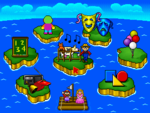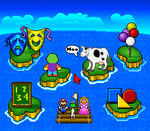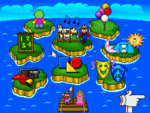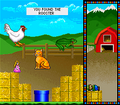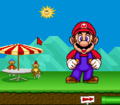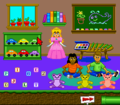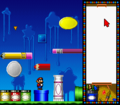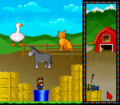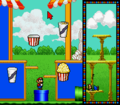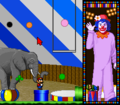Mario's Early Years! Preschool Fun: Difference between revisions
| Line 77: | Line 77: | ||
===[[Listening World]]=== | ===[[Listening World]]=== | ||
This world is similar to a farm. Here, the player must wake up a sleeping Luigi to start. Three animals are shown and a sound is played. The player must click the animal that makes the indicated sound. | This world is similar to a farm. Here, the player must wake up a sleeping Luigi to start. Three animals are shown and a sound is played. The player must click the animal that makes the indicated sound. In the CD Rom collection version of the game, three more stages are added. | ||
===[[Opposite World]]=== | ===[[Opposite World]]=== | ||
Revision as of 19:53, August 19, 2021
Template:Infobox Mario's Early Years! Preschool Fun, released in Europe as Mario's Playschool,[1][2][3] is an educational Mario game released in North America in 1994[4] for the MS-DOS[5] and SNES[6] developed for children under six years of age. The game is set around a group of islands, where each island teaches a different subject to the players. The overall design of the game is based of Super Mario World, where the character graphics are taken from it while the music features rearrangements of various tracks.
This was the last of three educational games to be released in the Mario's Early Years! series, the others being Mario's Early Years! Fun with Letters and Mario's Early Years! Fun with Numbers; as such, the game is very similar to the first two games of the series. The main difference between this entry is that the subjects in the islands cover a more general learning, such as learning opposites, colors, and animals. The game, alongside the other two Mario's Early Years! titles was re-released under Mario's Early Years! CD-ROM Collection in 1995.
Gameplay
Mario's Early Years! Preschool Fun is a point-and-click game, similar to other edutainment titles and the first two games of the Mario's Early Years! series. Players control the mouse cursor with the mouse in the MS-DOS version of the game, and the SNES version uses the controller that imitates mouse functions. In each of game's worlds, children's voice overs instruct players how to proceed. In worlds where players need to pick objects to proceed, the character moves and jumps to the location, hitting the object as if it were a block. Clicking on the various Warp Pipes takes players to further parts of the level, while clicking on Warp Pipes with an arrow pointing at them (yellow in the MS-DOS version, green in the SNES version) takes player back to the main menu.
Characters
Playable characters
The playable characters are the same across all three Mario's Early Years! titles. Players can pick their character by clicking on them in the main menu screen. In the MS-DOS version of the game, Mario and Princess Toadstool are the playable characters. In the SNES version of the game, Yoshi is added as a playable character.
Mario (MS-DOS)
Princess Toadstool (SNES)
Yoshi (SNES exclusive)
Supporting characters
| Image | Name | Description |
|---|---|---|
| Luigi | Luigi is found sleeping in most worlds. Players need to click on him to wake him up to start playing the games. He additionally shows up in the title screen, helping to assemble the letters. |
Background characters
These characters congratulate players if they made the correct choices in the stages. Subtitles are present in the SNES version of the game.
Bowser (MS-DOS)
Yoshi (SNES)
Koopa Troopa (MS-DOS)
Goomba (MS-DOS)
Goomba (SNES)
Ludwig von Koopa (MS-DOS)
Piranha Plant (MS-DOS)
Worlds
Mario's Early Years! Preschool Fun contains seven worlds in the DOS version of the game, six worlds in the SNES version of the game, and eight worlds in the CD-ROM collection version of the game. When the worlds are completed, players are automatically taken back to the main menu, which also acts as the world selection.
Shape World
This world contains many art-related objects, such as pencils and ink jars. Here, the player must click on the indicated forms to make a picture. Luigi is sleeping, click on him so he will be awakened in order to start the game. When a form is clicked, Mario approaches and strikes it, resulting in the form being transported to the canvas.
Counting World
This world is similar to a child playroom. Here, the player can count objects. When a group is tapped, the objects will be counted while the children in the room show the number with their fingers.
Body World
This world contains a grassy area with mountains in the background. Here, the player can click on some of Mario's body parts. If the player clicks on Mario's cap, it floats and show Mario's hair. If Mario's right hand is clicked, he snaps his fingers. If Mario's left hand is clicked, Mario claps his hands. If Mario's right foot is clicked, he taps it on the ground. If Mario's nose is clicked, he shakes it a bit.
The player can also click the monkeys in the background, causing them to wave. The sun in the background can be clicked, causing it to raise its eyebrows.
Listening World
This world is similar to a farm. Here, the player must wake up a sleeping Luigi to start. Three animals are shown and a sound is played. The player must click the animal that makes the indicated sound. In the CD Rom collection version of the game, three more stages are added.
Opposite World
In this world, the player must click the opposite item to the one that is being indicated at the top of the screen. The player must wake Luigi up first.
Color World
In this world, the player must first wake Luigi up. Then the game will indicate some pictures and their color. The player must click on the indicated object.
Sing Song World
A world where nursery rhymes/children songs are reenacted with the Mario cast. Such as I'm a Little Teapot, the English alphabet song, Old MacDonald Had a Farm, The Wheels on the Bus, and Itsy Bitsy Spider.
Time World
Exclusive to the Mario's Early Years! CD-ROM Collection version of the game, this world deals with time-related subjects. Players watch through the seasons, life cycles for people, plants, butterflies, and frogs, the months of a calendar, and the day and night.
Console differences
The SNES version of the game is largely the same as the PC edition, but with some differences due to reduced space.
- The main menu of the DOS version of the game uses a rearrangement of the map theme for Donut Plains while the SNES version uses the title screen theme. The icons are also in slightly different places.
- Options to turn off music/sounds/voice clips, randomize the questions, and show text in worlds that have it were removed.
- The help screen with tips on how to continue learning outside of the program was removed.
- Yoshi was added as a third playable character.
- Various background graphic differences.
- Like its predecessors, Sing Song World was removed.
Staff
- Main article: List of Mario's Early Years! Preschool Fun staff
Gallery
It has been requested that more images be uploaded for this section. Remove this notice only after the additional image(s) have been added.
Screenshots
Body World in the SNES version.
Body World in the MS-DOS version.
Sprites
A Koopa that resembles Ludwig von Koopa
Quotes
Some quotes from children instructing players are compiled from separate sound bytes.
- That works for me!
- Mario likes you.
- Wow, you did it.
- Good choice.
- You did well.
- I like your choice.
- I know that's right.
- Well done.
- You are good!
- Great!
- Good for you.
- You found it!
Media
| It has been suggested that audio and/or video file(s) related to this section be uploaded. Reason: SNES and DOS Please upload all related music, sound effects, voice clips, or any videos for this section. See the help page for information on how to get started. |
References
- ^ YouTube video of the MS-DOS version released in Europe (Retrieved July 21, 2019)
- ^ TCRF: Mario's Early Years (DOS) (Retrieved July 21, 2019)
- ^ Archive.org - Mario's Playschool
- ^ Nintendo Power Volume 67, Page 105
- ^ YouTube video of the MS-DOS version (Retrieved August 9, 2011)
- ^ YouTube video of the SNES version's introduction (Retrieved August 9, 2011)
| Mario's Early Years! Fun with Letters / Mario's Early Years! Fun with Numbers / Mario's Early Years! Preschool Fun | |
|---|---|
| Characters | Mario • Luigi • Princess Peach • Toad • Yoshi • Baby Yoshi |
| Enemies | Piranha Plant • Goomba • Bowser • Larry Koopa • Iggy Koopa |
| Worlds (Fun with Letters) |
First Letter World • Vowel World • Alphabet World • Sentence World • Building World (SNES · PC) • Sound World • Last Letter World • Sing Song Worlda • Story Worlda |
| Worlds (Fun with Numbers) |
Number World • Counting World • Comparing World • How Many World • Shape World • Same and Different World • Sorting World • Sing Song World |
| Worlds (Preschool Fun) |
Shape World • Counting World • Body World • Listening World • Opposite World • Color World • Sing Song World • Time World |
| Other | Warp Pipe • Gallery (Preschool Fun) |
